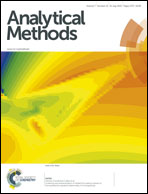Method validation for the analysis of licorice acid in the blending process by near infrared diffuse reflectance spectroscopy†
Abstract
The present work describes the validation of the near infrared (NIR) method for the quantification of the concentration of licorice acid in the blending process of licorice and talcum powder mixtures. The NIR diffuse reflectance spectra of samples were collected during the mixing process and the partial least squares (PLS) model was developed. The accuracy profile (AP) approach that was fully compliant with the ICH Q2 (R1) guidelines was used in order to assess the validity of the NIR chemometric method. Particularly, the β-content, γ-confidence tolerance interval, instead of the β-expectation tolerance interval in the AP methodology, was introduced to provide a better estimate of measurement risk. The quantitative validation criteria such as trueness, precision (both repeatability and intermediate precision), result accuracy and valid range were obtained. The lower limit of quantification (LLOQ) was 1.26 mg g−1. The results demonstrated that NIR spectroscopy is suitable for the analysis of the concentration of licorice acid. And the risk of using the established analytical method in the routine phase could be well visualized and controlled.


 Please wait while we load your content...
Please wait while we load your content...